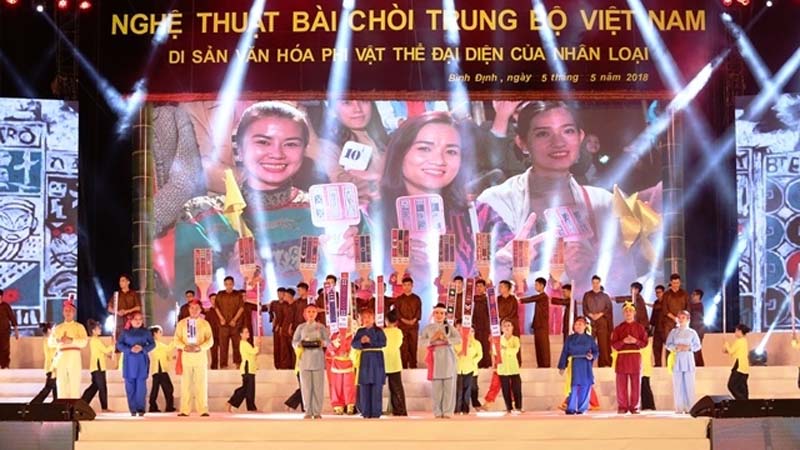
A ceremony was held in Binh Dinh province on May 5, to receive a certificate recognising bai choi, a form of folk singing popular in central Vietnam, as a UNESCO intangible heritage of humanity.

A
bai choi performance at the ceremony
The event was attended by Prime Minister Nguyen Xuan Phuc and the
UNESCO chief in Vietnam Michael Croft, as well as foreign diplomats and artists
from provinces where bai choi is practised.
An indispensable cultural element of people in the central provinces, the
content ofbai
choisinging reflects the
love for the homeland, community relationships and life experiences.
The art also helps to shape the qualities that
characterise the people of central Vietnam: frankness, sincerity,
simplicity, toughness, optimism and hospitality.
Speaking at the ceremony, PM Phuc stated that cultural
heritages are a valuable asset of communities and the preservation and
promotion work is significant for nurturing patriotism and strengthening
national solidarity.
For his part, Binh Dinh, Chairman Ho Quoc Dung, affirmed
that the provinces where bai choi is practised are determined to effectively
implement a scheme on promoting the heritage.
The ceremony also featured a wide range ofbai
choiperformances as well as
other songs and dances typical of the central region.
Source:NDO
Hoa Binh province has carried out multiple programmes and initiatives to revive its cultural heritage which has gradually fallen into oblivion through the ebbs and flows of history.
The most prominent and defining feature in the prehistoric era of Hoa Binh is the Hoa Binh Culture. The Culture was first discovered in Hoa Binh. The significant prehistoric culture represents not only Vietnam but also Southeast Asia and southern China. Through excavations of cave sites in the limestone regions of Hoa Binh, French archaeologist M. Colani introduced the world to a "Stone Age in Hoa Binh province – Northern Vietnam" in 1927. On January 30, 1932, the First Congress of Far Eastern Prehistorians, held in Hanoi, officially recognised the Hoa Binh Culture.
Known as the "Land of Epic History”, Hoa Binh province, the gateway to Vietnam’s northwest, boasts a strategic location and a unique cultural tapestry woven by its ethnic minority communities.
The People's Committee of Luong Son District recently held a ceremony to receive the certificate recognizing Sau Communal House in Thanh Cao Commune as a provincial-level historical and cultural site.
Recognising the importance of cultural heritage preservation in protecting and promoting the value system of Vietnamese culture, and serving socio-economic development in the new period, Party committees and local administrations in Hoa Binh province have identified it as a key task in the cultural development strategy. The province has been making efforts in mobilising resources, creating consensus among people and engaging ethnic communities in preserving and promoting cultural identity.
Hoa Binh province has captured growing attention both domestically and internationally for its distinctive cultural heritage and rich history. Most notably, it has been renowned for its famous Hoa Binh culture, considered the cradle of ancient Vietnamese civilisation. Looking ahead to significant milestones in 2025 and the 140th anniversary of province establishment in 2026, Hoa Binh Newspaper presents a comprehensive overview of the province's development across economic, social, cultural, tourism, and security domains.


